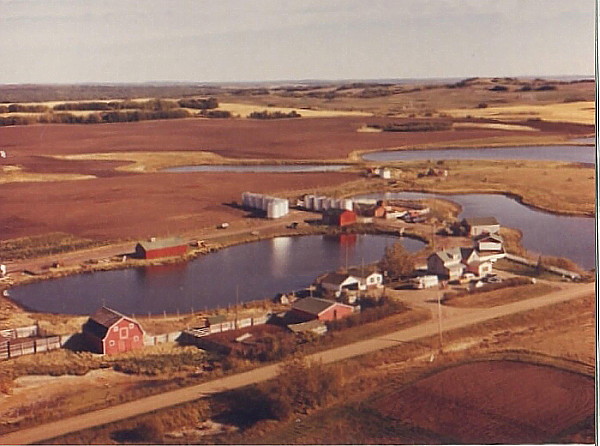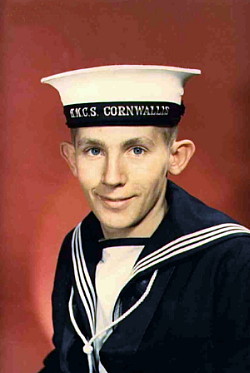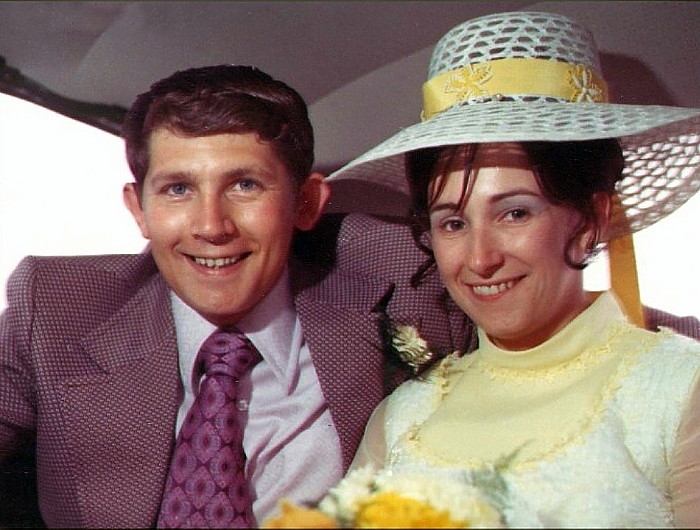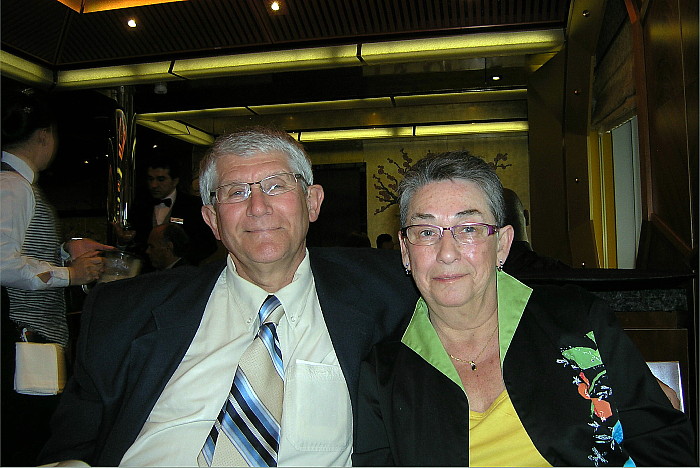
The farm of Lionel & Rita Benoit, north of Chauvin, Alberta. Photo taken in 1976.
My Naval Career and Beyond
By Brian Lapierre.
I was born in Wainwright, Alberta on 05 October 1948. I was raised on farms, and when I was thirteen years old went to live with an aunt and uncle on their farm in Chauvin, Alberta. Growing up I had been in Navy Cadets so this had an influence on me in joining the Navy.

On the 20th of September 1966 I got on a bus in Chauvin, Alberta and travelled to Edmonton to join the Royal Canadian Navy. Having never been to the big city before when I got off the bus I turned the wrong way on Whyte Avenue and got lost and didn't arrive at the Recruiting Center until 12:15 pm. First thing I got "dumped" on because I was supposed to be at the Recruiting Center at 12 noon sharp. I hadn't even signed up yet and felt like my career was down the "tubes". Anyway myself and a few others got sworn in. I chose "H" after my official number because I wanted to go east and hoped to go to Expo 67 in Montreal. After swearing in we travelled by bus to Calgary for three days of PSO Trades selection training at Currie Barracks. I was selected to be an Electrician E. Tech 331. Of course they always asked you if you wanted to be a stoker, cook or steward. Nothing against those trades but couldn't see myself being one of those.
Upon completion at Currie Barracks in Calgary we took the train back to Edmonton where we got on the CN Rail Super heading east. All along the trip we picked up more recruits whether they were Army, Navy or Air Force. This was still before Unification so we were all heading to different training bases. I can remember the Army guys getting off somewhere in Ontario and the Air Force guys getting off in Montreal to go to their respective training bases. Us Navy guys, about 30 of us, ended up in Saint John, New Brunswick where we then had to walk from the train station to the ferry which then took us across the Bay of Fundy to Digby, Nova Scotia. In Digby we were met by RCN personnel where we went by bus to HMCS Cornwallis. The very first days were very scary – not knowing what to expect and meeting new people. We had about 80 men and were to become Division Terra Nova 2/66. The first week consisted of getting your kit, learning how to iron, mark and sew your kit and polish your boots. With my first pay I bought my first Kodak Instamatic camera and haven't stopped taking pictures since. I continue to say I wish I had my digital camera 45 years ago.
A week or so after getting to Cornwallis I celebrated my 18th birthday. Again meeting new friends and learning who were good guys and the bad guys. Eventually some of the guys couldn't "cut it" and got released or failed out. Some got re-classed to other divisions as well. I see by the time we completed our training in February 1967 we only had 48 members left in the Division.
There was a Christmas break where people went home if they had saved the money. I did and travelled back to Alberta by train and then flew back to Halifax and then took the train back to Cornwallis.
I was pretty good in hockey and played for the Cornwallis Cougars. It used to be good to be in the middle of rifle or marching drills to be called out and dismissed so I could go to practice. I was a goalie and the other goalie was a PT Instructor by the name of Doug Milen. He was one of the "premier" goalies in the military at that time. We always had a rivalry with the Greenwood Bombers and the local team from Digby with all the "Van Tassel" players. The Commandant of HMCS Cornwallis at the time was Captain Paul and the XO was Commander Vondette.
After I completed Basic Training in February 1967 I got to stay in Cornwallis to continue to play hockey with the Cougars. I was a "White Hat" and my days consisted of exercising by day and practicing hockey. Pretty good life. We went to St. Pierre & Miqueleon to play hockey and also played a team from the Boston area besides the teams from Halifax, Greenwood and Digby.
The day after the hockey season ended I was on the train to Halifax to get on with my trades training in HMCS Stadacona. This was where I spent the next two months during my basic electrician's course. When I found the Electrical School the Chief said they had been looking for me for two months. I explained that I had stayed in Cornwallis to play hockey. He wasn't impressed. I completed this course in June 1967 and pretty well the entire course was drafted to HMCS Bonaventure which was in refit in Lauzon, Quebec. So off we went to Lauzon by train and I spent the whole summer of 1967 in Lauzon, Quebec City and on weekends going to Montreal to Expo 67. It was a great summer. Myself and a stoker by the name of Bob Turtle from Saskatchewan met two American girls who were going to Laval University for the summer. One had a car so we had great weekends and trips to Montreal. We had lots of money because we were getting $35.00 a week living ashore allowance and it was costing us only $7.00 a week for a room.
With the summer being over and Bonaventure's refit over, the ship transited to Halifax for more trials. I spent from June 1967 to May 1969 on Bonaventure. Trips to Bermuda, Caribbean for "Maple Spring" and in the North Atlantic shadowing the Soviet Fleet and my first trip to the UK, Ireland and Denmark. In May 1969 I returned to Stadacona and completed my Trade Group II Course.
It was during this time of Unification and drastic changes to all three services. Many of the guys I knew took release and got out. Many I have never seen since.
Upon completion of this training I decided to volunteer for the Submarine Service. I completed my Basic Submarine Training in June 1969 and was posted to HMCS/M Onondaga. I spent six months on Onondaga and then I was drafted to HMCS/M Okanagan. This was where I spent the next five and a half years. During this time from Sept 1972 to March 1973 I again was back in Stadacona to complete by E. Tech 331 Trade Group III Course. When this was completed it was back to Okanagan where she was just finishing her refit and we headed to the UK for our workups. We had a real good Electrical Department on Okanagan. It consisted of CPO2 Dick Newman, PO1 Charlie Hillier, MS Bob Rockley, MS Paul Renner, MS Jack Molloy, LS Dave Yeo, LS Larry Smith and myself LS Brian Lapierre. Charlie, Bob & Jack have since crossed the bar.
HMCS Okanagan had a very good workup for four months. One of the highlights was completing the Escape Training Tank in "Dolphin" Gosport. Unfortunately it all came crashing down when with 23 minutes left in the workups at 0743 on 28 July 1973 we struck the bottom of RFA Grey Rover in the Clyde not far from Faslane. No one was injured but we suffered considerable fin damage. We spent the next ten days in Faslane getting it repaired, periscope removed and blanked off for our transit on the surface back to Halifax. I was the unofficial boat's photographer at this time so managed to get some pretty good shots of the damage plus a photo from a cook off of the Grey Rover of Okanagan shortly after she had surfaced. A one of a kind.
In the summer of 1975 I was a Master Seamen and asked to go back to "General Service" to get some experience with AC Ships. I was sent to HMCS Nipigon until January 1976 where I was sent back to Okanagan again. In September 1976 I was promoted to Petty Officer 2nd Class, and in March 1977 was finally returned to "General Service". I was drafted to HMCS Margaree where we promptly left on a four month NATO exercise. I served on Margaree until early 1979 where I submitted my name to be considered for "Control Tech" which was the Navy's term for the Control Systems Technician on the 280 Class Gas Turbine Ships. At that time the Navy took Marine Engineers and Marine Electricians and gave them the same training to be the Control Systems Technician. Upon completion I was drafted to HMCS Iroquois where I spent from September 1979 to June 1983. In September 1979 I was promoted to Petty Officer 1st Class. While Iroquois was in refit I also did a NATO trip on HMCS Athabaskan.
In June 1983 I finally saw my first shore draft to Fleet Maintenance Group Atlantic. (FMG-A). I was only there for a couple of months when I was sent to the Engineering School in Stadacona to become one of the instructors in the Gas Turbine and Controls Sections. This would be the continuation of my training in Gas Turbines and Controls. In June 1984 I was promoted to Chief Petty Officer 2nd Class and stayed in the Fleet School instructing until May 1988. In the fall of 1987 I was on Captain Dave Pollard's Submarine Task Force to evaluate what training was required to transition from a destroyer Steam Driven plant to a Nuclear Steam Driven plant. The highlight of this Task Force was our trip around the world in 28 days to the Netherlands, England, Scotland, Singapore and Australia. One month after the report was completed the whole idea was scrapped. Another waste.
At that time the Navy was going through a transition with all the talk of Nuclear submarines, and I was back to submarines again. The Navy decreed that they needed qualified Chief Electricians in submarines so back I went. This time back to HMCS/M Onondaga which had been my first submarine in 1969. I stayed onboard Onondaga until 01 December 1988 where I figured that I'd had enough of the Navy and couldn't see my career going anywhere in submarines with all of my Controls Systems training. I retired from the Navy on 01 December 1988 and began to work for Paramax Electronics in the new Frigate building program. I was involved in the Integrated Machinery Control System (IMCS) which was cutting edge technology for the new frigates.
I worked for Paramax / Unisys / Loral / Lockheed Martin until the end of the Frigate program in July 1996 when we delivered the last ship, HMCS St. John's. I had the good fortune to have worked on all twelve ships and to do builders sea trials on nine of the 12 ships.
In May 1997 I began to work for Canship Ugland in the Hibernia project and spent four months in Koje Island, South Korea and commissioned the Shuttle Tanker MV Kometik. I was also on Kometik when we brought the first load of oil from Ras Tanura, Saudi Arabia to Paulsboro, New Jersey. At the same time I was on Kometik when we received the first load of oil from the Hibernia platform. Very memorable times in my career.
In March 1999 I began to work for Secunda Marine Services and flew to Japan to join the Cable Layer CS Agile. Quite a step down from a new shuttle tanker but got to see a bit of the Far East while we laid fibre optic cable around the China Sea. I worked for Secunda during the 9/11 attacks and then with the failure of the financial markets and the cable laying business I was laid off in April 2002.
From April 2002 to March 2007 I worked at various offshore jobs with various companies including Canadian Coast Guard, Global Santa Fe, Torch Offshore, Tidewater, C-Mar Canada and MMS. In 2004 I even went back to Alberta to try my hand in Fort McMurray but that life wasn't for me and eventually I came back to work in the offshore. In 2005 I spent three months in Yantai, China while with Tidewater building Anchor Handler vessels.
I began to work again for Secunda Marine Services in March 2007. In September 2007 Secunda was purchased by McDermott International and the Canadian company is J. Ray McDermott Canada Ltd. I spent two years on the Dive Support Vessel DSV Bold Endurance working in the Gulf of Mexico, a couple of trips on the DSV Emerald Sea in the Arabian Gulf, and then worked as an Electronics Officer / Dynamic Positioning Technician from January 2010 to September 2016 on the DSV Thebaud Sea working in the Arabian Gulf for McDermott Middle East. When I came home in early September 2016, I decided to retire and made it official on 20th September 2016, to coincide with my 50th anniversary of joining the Royal Canadian Navy on 20th September 1966. A nice round figure.
I continue to live in Portuguese Cove in the Halifax area with my wife of 51 years as of June 2023. On my time off we like to travel and cruise. We have two sons and four grandsons.

Brian Lapierre & Karen Mongrain, 17 June, 1972, Dartmouth, Nova Scotia.

Brian & Karen Lapierre, 2012.